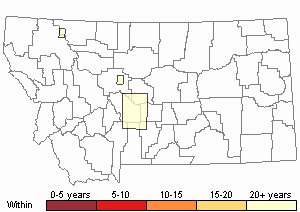View in other NatureServe Network Field Guides
NatureServe
Montana
Utah
Wyoming
Idaho
Wisconsin
British Columbia
South Carolina
Yukon
California
New York
Obtuse Leaf Tortula Moss - Tortula obtusifolia
Other Names:
Desmatodon obtusifolius
General Description
Plants: Acrocarpous (Vitt 1988). Growing in dense cushions or clumps of erect shoots, not shiny (Crum & Anderson et al. 1981), green above (FNA 2007), occasionally tinted with brown or red (Flowers 1973), brownish below (FNA 2007). Stems 3-6 mm (Crum & Anderson et al. 1981), possessing a frequently faint central strand, (Flowers 1973); axillary hairs to 8 cells long, the distal cells with thinner walls (FNA 2007).
Leaves: Upright against the stem and infolded when dry, spreading slightly to broadly when wet (FNA 2007), lance-shaped and sometimes with ovate tendencies (Crum & Anderson et al. 1981) to oblong or tongue-shaped (Lawton 1971), the leaf tip curved to widely acute and with a short point (FNA 2007); leaf edges smooth (Lawton 1971), rolled back and down from close to the base to near the apex, sometimes tightly; costa disappearing in the apiculus, or extending to or near to the leaf tip (FNA 2007).
Leaf Cells: Basal cells quadrangular with thin, transparent walls; upper laminal cells nearly square to 6-sided, ca 1:1, covered with papillae of varying complexity; margins bordered above either with several rows of cells with more thickly-walled cells or with diamond-shaped cells often concealed in the rolled portion; costa in X-section semi-circular, with ventral epidermis, guide cells (usually in 1 row), hydroid strand, a strong dorsal stereid band, and dorsal epidermis all present (FNA 2007).
Phenology
Fruit ripens spring through autumn (FNA 2007).
Diagnostic Characteristics
The male and female branches quickly split from each other, and then appear dioicous (Flowers 1973).
Range Comments
North American Range
Canada: BC to NB (except SK); USA: AK and many of the continental states (unknown in OR, ID, and NV, ND, KY e to MD and s to SC, AR to FL, and NY ne to ME) (FNA 2007). Known in Montana from Cascade, Fergus, Gallatin, Glacier, Rosebud, and Park Counties (Elliott 2016).
Observations in Montana Natural Heritage Program Database
Number of Observations: 5
(Click on the following maps and charts to see full sized version)
Map Help and Descriptions
Relative Density

Recency


 (Observations spanning multiple months or years are excluded from time charts)
(Observations spanning multiple months or years are excluded from time charts)
Habitat
Soil and calcareous rock shelves, walls, and fissures (FNA 2007), mortar and concrete (Crum & Anderson et al. 1981). Elevation: 0-10,830 feet (FNA 2007).
Reproductive Characteristics
Autoicous, but plants frequently with either male or female gametangia. Seta brownish, 5-8 mm tall. Capsule upright, scarcely curved (FNA 2007), slender and cylindrical, creased when dry (Crum & Anderson et al. 1981), borne above the perichaetial leaves; theca 1-2.5 mm in length; peristome basic, with 16 teeth split to the bottom, some very short, the longer ones thread-like and sometimes slightly spiraled. Calyptra hood-like (FNA 2007).
Stewardship Responsibility
References
- Literature Cited AboveLegend:
 View Online Publication
View Online Publication Crum, H.A. and L.E. Anderson. 1981. Mosses of Eastern North America. 2 volumes. Columbia University Press, New York. 1328 pp.
Crum, H.A. and L.E. Anderson. 1981. Mosses of Eastern North America. 2 volumes. Columbia University Press, New York. 1328 pp. Elliott, J.C. and A.K. Pipp. 2018. A Checklist of Montana Mosses (1880-2018). Updated 3 January, 2020. Montana Natural Heritage Program, Helena, Montana. 73 pp.
Elliott, J.C. and A.K. Pipp. 2018. A Checklist of Montana Mosses (1880-2018). Updated 3 January, 2020. Montana Natural Heritage Program, Helena, Montana. 73 pp. Flora of North America Editorial Committee, eds. 2007. Flora of North America North of Mexico. Volume 27. Bryophytes: Mosses, Part 1. Oxford University Press, Inc., NY. xxi + 713 pp.
Flora of North America Editorial Committee, eds. 2007. Flora of North America North of Mexico. Volume 27. Bryophytes: Mosses, Part 1. Oxford University Press, Inc., NY. xxi + 713 pp. Flowers, S. 1973. Mosses: Utah and the West. Brigham Young University, Provo, Utah. 567 p.
Flowers, S. 1973. Mosses: Utah and the West. Brigham Young University, Provo, Utah. 567 p. Lawton, E. 1971. Moss Flora of the Pacific Northwest. Hattori Botanical Laboratory. Japan: Yamabuki-cho, Shinjuku-ku, Tokyo. 362 pages plus appendices.
Lawton, E. 1971. Moss Flora of the Pacific Northwest. Hattori Botanical Laboratory. Japan: Yamabuki-cho, Shinjuku-ku, Tokyo. 362 pages plus appendices. Vitt, D. J. Marsh, and R. Bovey. 1988. Mosses, Lichens & Ferns of Northwest North America. Seattle, WA: University of Washington Press. 296 p.
Vitt, D. J. Marsh, and R. Bovey. 1988. Mosses, Lichens & Ferns of Northwest North America. Seattle, WA: University of Washington Press. 296 p.
- Additional ReferencesLegend:
 View Online Publication
View Online Publication
Do you know of a citation we're missing? Elliot, J. C. 1993. Second checklist of Montana mosses. Unpublished report. U.S. Forest Service, Region 1. Missoula, MT. 45 pp.
Elliot, J. C. 1993. Second checklist of Montana mosses. Unpublished report. U.S. Forest Service, Region 1. Missoula, MT. 45 pp. Lawton, E. 1971. Keys for the Identification of the Mosses on the Pacific Northwest. Reprinted from 'Moss Flora of the Pacific Northwest'. Published as Supplement No. 2 of the Journal of the Hattori Botanical Laboratory. Nichinan, Miyazaki, Japan. 66 pp.
Lawton, E. 1971. Keys for the Identification of the Mosses on the Pacific Northwest. Reprinted from 'Moss Flora of the Pacific Northwest'. Published as Supplement No. 2 of the Journal of the Hattori Botanical Laboratory. Nichinan, Miyazaki, Japan. 66 pp. Malcolm, B., N. Malcolm, J. Shevock, and D. Norris. 2009. California Mosses. Nelson, New Zealand: Micro-Optics Press. 430 pp.
Malcolm, B., N. Malcolm, J. Shevock, and D. Norris. 2009. California Mosses. Nelson, New Zealand: Micro-Optics Press. 430 pp.
- Web Search Engines for Articles on "Obtuse Leaf Tortula Moss"





